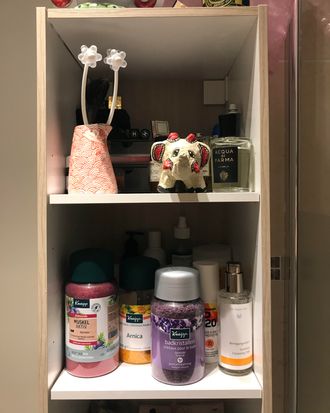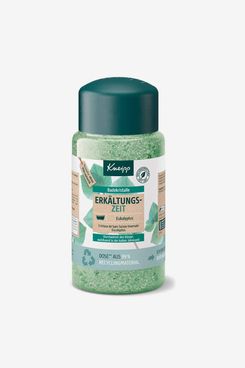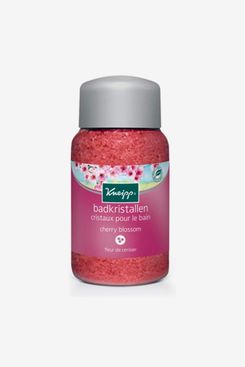
The icy winds and minus-two-degrees-Celsius snow were enough to put me in a firm stay-at-home mood when I moved to Berlin in January 2018. Berlin’s winters are tough, but that winter was a particularly bitter one, making it pretty impossible to socialise after hours or navigate the cavernous Berlin boulevards and not get frostbite. With lots of free time on my hands in my new apartment, I wanted something to pass the time, and baths seemed like a no-effort pastime.
Berlin isn’t really one of those European cities with adorable 200-year-old pharmacies like Paris or Florence. The city has two pharmacy chains, and they’re usually located in big old Soviet department stores or depressing malls built in the 1990s. So I went to my local dm-drogerie markt, a megachain drugstore that sells ant poison a few aisles down from the shower gels and bubble baths, hoping to find a niche German brand that I could show off to my friends back in London. I wasn’t disappointed.
Happily scrutinising products at the Karl-Marx-Straße dm in Neukölln, I noticed a fluoro-orange row of little tubs of bath salts with a whimsical Kneipp scrawled in italics across the front. I’d seen Kneipp bath oils before, in earnest health-food shops in London, but I didn’t know its salty backstory. This handwritten logo is the signature of Herr Kneipp, a Bavarian priest who shook up Germany in the 1850s with Kneippism, in which he suggested people plunge themselves into baths full of herbs and salt. The salts are the legacy of Kneipp’s water cure and are why, for Germans, Kneipp bath salts conjure a beige 1970s four-piece bath suite, complete with shag pile carpet.
I put “Valerian & Hops” in my basket, and it became my gateway Kneipp. The recommended capful quickly turned my bath into a bright blue pool of a medicinal, pungent scent and left my skin feeling salty but wholesome. Impressed by this flagrant disregard of the usual bubble bath floral and girly smells, I sampled other available Kneipps, always careful to pick through scent, not colour. Scents were, at times, bizarre. There’s “Melissa,” which smells like a fading rosebush, and “Eucalyptus,” which is like a doctor-prescribed cold remedy that you really have to brace yourself for. My favourite Kneipp remains “Cherry Blossom,” with a tough mineral scent that completely overpowers the vaguely fruity notes.
While other German beauty brands like Weleda and Dr. Hauschka rely on their undercut cool for reputation, there is just nothing fashionable about Kneipp. But in my two years as a Kneippist, I’ve converted many friends to Kneipp through gifted tubs, making committed fans out of news editors who had once relegated baths under trite self-care and men who previously never would have been seen dead with a purple bath salt by their tub. I’m now back in London but replenish my stock whenever I’m in Berlin. While Germans may consider the brand fuddy-duddy, I prefer to think of it as my 19th-century water cure.
My preferred Kneipps
The Strategist UK is designed to surface the most useful, expert recommendations for things to buy across the vast e-commerce landscape. Read about who we are and what we do here. Our editors update links when possible, but note that deals can expire and all prices are subject to change.

